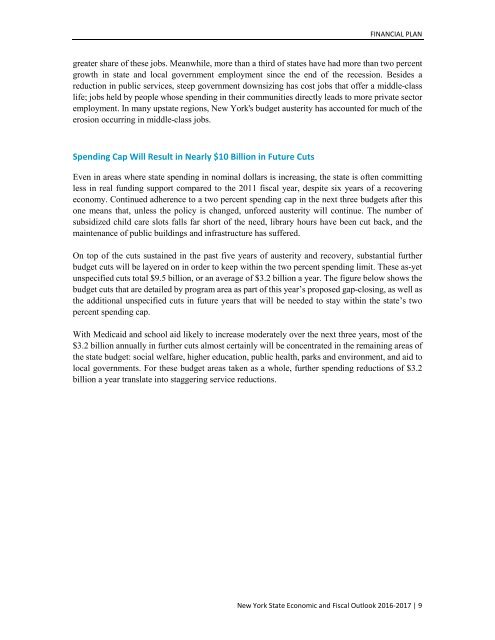2016-2017
1PSJ98W
1PSJ98W
You also want an ePaper? Increase the reach of your titles
YUMPU automatically turns print PDFs into web optimized ePapers that Google loves.
FINANCIAL PLAN<br />
greater share of these jobs. Meanwhile, more than a third of states have had more than two percent<br />
growth in state and local government employment since the end of the recession. Besides a<br />
reduction in public services, steep government downsizing has cost jobs that offer a middle-class<br />
life; jobs held by people whose spending in their communities directly leads to more private sector<br />
employment. In many upstate regions, New York's budget austerity has accounted for much of the<br />
erosion occurring in middle-class jobs.<br />
Spending Cap Will Result in Nearly $10 Billion in Future Cuts<br />
Even in areas where state spending in nominal dollars is increasing, the state is often committing<br />
less in real funding support compared to the 2011 fiscal year, despite six years of a recovering<br />
economy. Continued adherence to a two percent spending cap in the next three budgets after this<br />
one means that, unless the policy is changed, unforced austerity will continue. The number of<br />
subsidized child care slots falls far short of the need, library hours have been cut back, and the<br />
maintenance of public buildings and infrastructure has suffered.<br />
On top of the cuts sustained in the past five years of austerity and recovery, substantial further<br />
budget cuts will be layered on in order to keep within the two percent spending limit. These as-yet<br />
unspecified cuts total $9.5 billion, or an average of $3.2 billion a year. The figure below shows the<br />
budget cuts that are detailed by program area as part of this year’s proposed gap-closing, as well as<br />
the additional unspecified cuts in future years that will be needed to stay within the state’s two<br />
percent spending cap.<br />
With Medicaid and school aid likely to increase moderately over the next three years, most of the<br />
$3.2 billion annually in further cuts almost certainly will be concentrated in the remaining areas of<br />
the state budget: social welfare, higher education, public health, parks and environment, and aid to<br />
local governments. For these budget areas taken as a whole, further spending reductions of $3.2<br />
billion a year translate into staggering service reductions.<br />
New York State Economic and Fiscal Outlook <strong>2016</strong>-<strong>2017</strong> | 9


